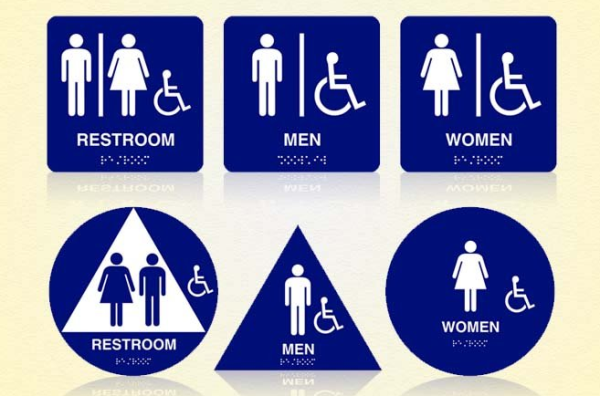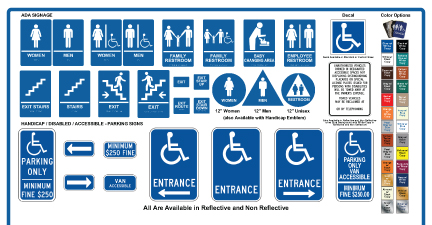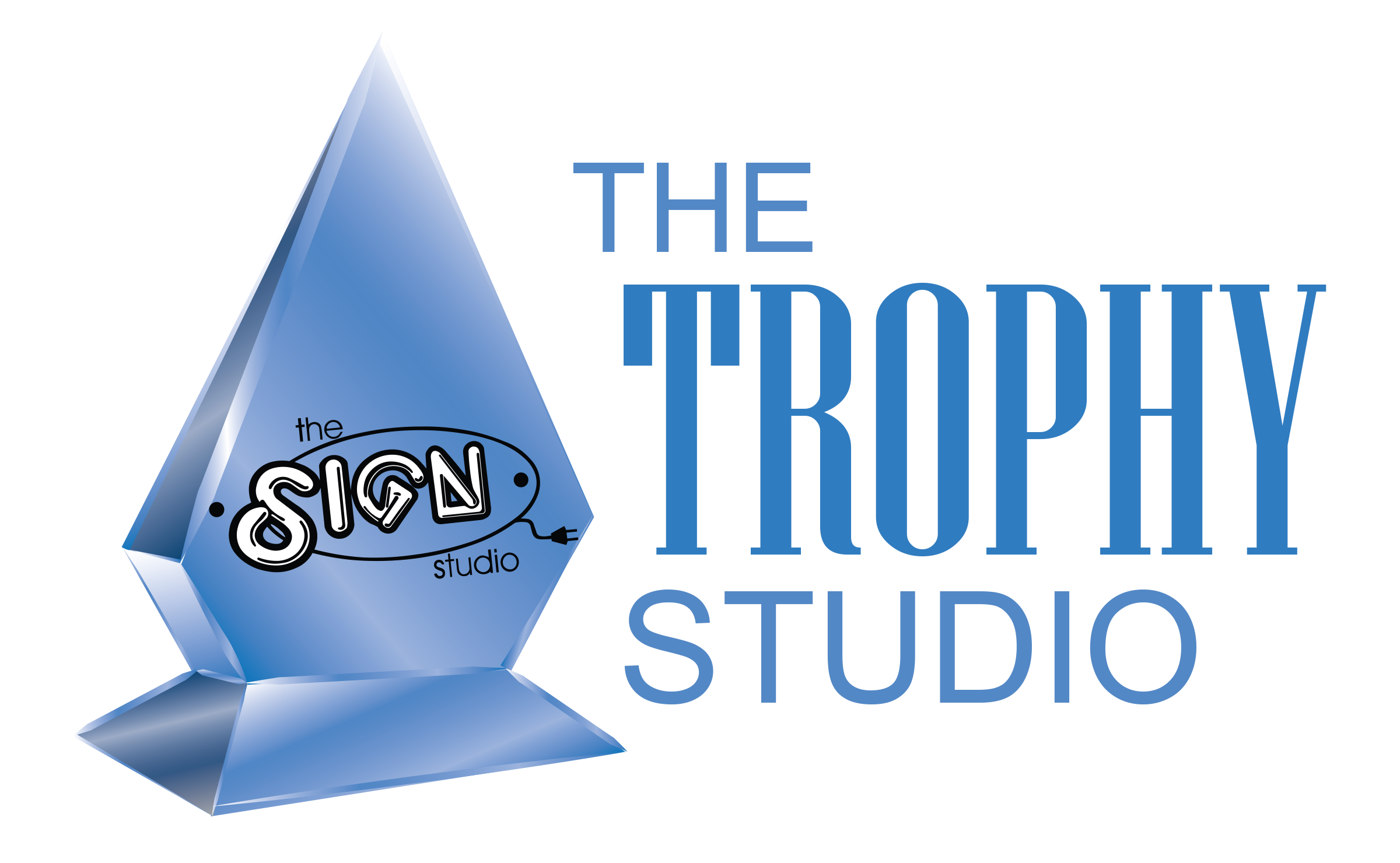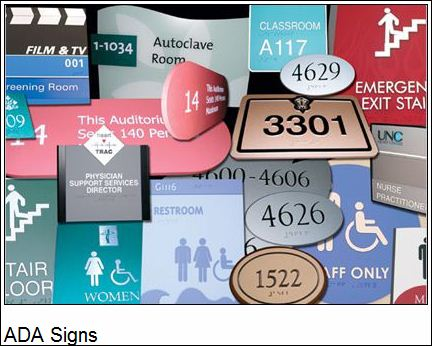ADA COMPLIANT RESTROOM SIGNS

New ADA Laws and Regulations
Many businesses don't realize there is a far-reaching and organized series of laws and procedures that govern bathroom signs and handicapped signage. The ADA, the Americans with Disabilities Act, was enacted to give due diligence to making sure that all public spaces, including restrooms and places where industrial signage is needed, are accessible and familiar to the handicapped person.
Recently, the laws regulating ADA restroom signs, and all ADA signs in general, have changed. New legislation has brought all the old ADA signage up to modern codes, and compliance is a must.
ADA signage refers to a lot of different laws and regulations, but some of the ADA restroom signs in particular that have been significantly affected by the new rules are braille signs. Braille signs are one of the most important aspects of restroom signage that ADA regulates, and with good reason. There are dozens of possible pitfalls when it comes to creating a braille sign, not least among them positioning, changes in braille itself, height, and prescribed size and lettering. For a handicapped person, it's absolutely essential that your bathroom signs speak to them in a way that they understand and are familiar with. These new laws make it that much easier to create informative, helpful, safe ADA restroom signs, and to create a braille sign that speaks to the widest possible audience as clearly as it can.
ADA signage is something that's easy to overlook in the rush to get through a job, or to design your interior space in a way that's pleasing to the eye and works with your business, school, hotel, or place of business. However, few things are more important about your ADA restroom sign than the way it speaks to the disabled. The right braille sign, the right ADA sign of any stripe, is designed to keep your business in good standing in two ways. One way is compliance. Without it, your space could be subject to penalties and even lawsuits, and that's never a good thing. The other way is simple customer/occupant care and service. Without the right kind of ADA signage, your handicapped patrons will have a harder time doing what they need to do in your space. Both of those simple, very compelling reasons for updating your signs are focused on here at The Sign Studio. .
Below you'll find a run down of many of the new ADA sign regulations that relate to industrial signage and braille signs. As a service to you and a guideline for how we make our signs in the future, we're placing these ADA regulations on our site - check back to reference them whenever you need. The Sign Studio is your one-stop shop for any kind of braille sign, ADA signage, or any type of state and federal law-compliant sign.
New Regulations Related to Braille Signs
According to the new regulations, when you're writing in braille there are several guidelines in reference to size, height, and font. For example:
"Letters and numerals shall be raised 1/32 in (0.8 mm) minimum, upper case, sans serif or simple serif type and shall be accompanied with Grade 2 Braille. Raised characters shall be at least 5/8 in (16 mm) high, but no higher than 2 in (50 mm). Pictograms shall be accompanied by the equivalent verbal description placed directly below the pictogram. The border dimension of the pictogram shall be 6 in (152 mm) minimum in height."
There are minimums for how far braille must be raised above the surface of your ADA sign, and at The Sign Studio we have the precision machines to get it just right, keep you compliant, and make your signs readable and accessible. We also are completely updated and able to write in perfect Grade 2 Braille, a capability not all sign companies share. We also are well trained and well versed when it comes to all ADA signage symbolics, and all related braille sign explanations and text.
Another set of regulations for braille signs:
Dot diameter: .059 in.
Inter-dot spacing: .090 in.
Horizontal separation between cells: .241 in.
Vertical separation between cells: .395 in.
Raised borders around signs containing raised characters may make them confusing to read unless the border is set far away from the characters. Accessible signage with descriptive materials about public buildings, monuments, and objects of cultural interest may not provide sufficiently detailed and meaningful information. Interpretive guides, audio tape devices, or other methods may be more effective in presenting such information.
As you can see, that kind of minute detailing requires incredible precision. That's why The Sign Studio has invested in the best, sharpest sign creation equipment. With laser precision, we can make ADA restroom signs to absolute perfect margins and regulations, and every ADA sign we make for your company can be crafted with amazing exactitude.
That's important not only to make your signs compliant, but also to make them readable. For braille users, it's important that braille signs be the same as the braille they read in texts, to cut down on confusion. Confusion that could range from mere frustration to the possibility of danger, neither of which serve you, your place of work, or your guests.
The signs in your space are important on a number of levels, but few of them are more important than respect and customer service. Making the best braille sign possible, in compliance with all ADA signage laws and regulations, is a great way of accomplishing both of those goals, and making them with precision and excellence is a point of pride for The Sign Studio. There are several other laws regulation ADA restroom signs. They include regulations related to height, spacing, and sign placement.
For instance, all ADA signs intended for use by handicapped persons have to be placed in locations free from any sort of unseen danger, such as the arc of a swinging door, or a protuberance along the wall. A braille sign has to be in a place where the user can feel safe standing still and reading it for any period of time.
"Letters and numbers on signs shall have a width-to-height ratio between 3:5 and 1:1 and a stroke-width-to-height ratio between 1:5 and 1:10."
This regulation ensures that the characters on a given sign will conform to other characters on other signs, making them familiar and readable. This goes for all kinds of ADA signage, and is one more way these ADA regulations make the world of interior space more palatable and easier to navigate for the handicapped.
There is also a regulation mandating that all bathroom signs be high contrast. In other words, if your writing is in a light color, like white, it must be contrasted with a darker background, like blue. You see this combination in a lot of different handicapped signage. The contrast must be 70% to be in full compliance, and the ADA provides a helpful equation to help businesses know how much contrast is enough:
Contrast = [(B1 - B2)/B1] x 100
where B1 = light reflectance value (LRV) of the lighter area and B2 = light reflectance value (LRV) of the darker area. Note that in any application both white and black are never absolute; thus, B1 never equals 100 and B2 is always greater than 0. The greatest readability is usually achieved through the use of light-colored characters or symbols on a dark background.
All of these rules and regulations are essential in crafting the most up-to-date, ADA compliant signs possible. For handicapped persons and those who depend on braille, the new regulations are essential to an improved, more familiar quality of life. The new braille signs that will now be produced are alone worth the effort of bringing your signs up to code. Using literary spacing and Grade 2 braille is an important step in leveling the playing field of industrial signage.
And when it comes to code-compliant, customer service oriented ADA signage, including of course ADA restroom signs, there's no better place to go than The Sign Studio.
If you have any questions or need further information, please give us a call at (818) 843-9200 or send us an e-mail at thesignstudio@sbcglobal.net












